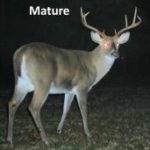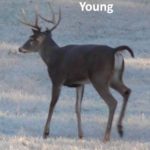
It takes practice, practice and more practice
Two of the cornerstone tenants of modern day “quality deer management” are herd monitoring and herd management.
Herd monitoring is where trail cameras can really come into play to assist in conducting various surveys on hunting property. On an annual basis your survey goals can span a range of topics that include determination of fawn-to-doe ratio, estimation of overall resident deer population, the tracking of seasonal buck/doe ratio and assessment of the age structure of your buck population.Naturally, being individuals with different likes and dislikes, not all of us are bonkers over the use of trail cameras.
On the other hand, herd management is something that we all love to be involved in during the fall and winter, as it involves the actual harvest of deer, and who among us does not savor the smell of fresh backstrap cooking on a grill?
This is where a third tenant of “quality deer management” comes into play. It is often referred to as hunter management.
A number of us like to also refer to this particular tenant as “trigger-finger management.” Each time a hunter pulls a trigger, a management decision is made by the hunter. Every single hunter on a given property has to be totally in sync with a given “trigger-finger management” plan for it to work.
When this particular concept is embraced and used effectively, dramatic results over time are usually the result in terms of age structure and rack size of a given affected buck population.
When I was first introduced to deer hunting in the early 1970s, and for a number of years thereafter, the topic of buck management could have been paraphrased on one line of a single page. And yes, I did say buck management and not deer management, because as crazy as it now sounds at that point in time doe harvest was highly regulated and restricted. For a time back then, here in Mississippi, a legal buck was defined as any buck that had antler material that “broke the hairline.”
When hunting, this created a very simple three-step process for the assessment of any buck that came into view:
“I see a deer.”
“Its a buck.”
BOOM!
Sadly, as a result, I had no clue about buck movement and behavior back in those days, since I never saw a buck alive on the hoof following step three.
Now let’s return to the present. A high percentage of today’s deer hunters are interested to one degree or another in the age, rack size and score of harvested bucks. To maximize rack size and score, a given buck has to reach maturity, and the only way for a buck to reach maturity is for us as hunters to let him walk until he reaches a target age point.
If our goal is to maximize buck age and the resulting rack size and score, we have to reduce or eliminate the harvest of younger aged bucks. To accomplish this task, hunters must become proficient at estimating the age of live deer “on the hoof,” both in trail camera photographs and in the field.
The old wives tale about using antler points to estimate a buck’s age has long been scientifically debunked; this is not a reliable feature when estimating age.
In the field, the art of on-the-hoof aging yields nothing more than an educated guess as to deer age, but with some study of the basic principles involved and lots of practice, one can become quite proficient at age estimation.
Even the most-experienced hunters among us will make an occasional mistake, but unlike fishing if you do make a mistake, you unfortunately cannot throw the buck back in the water.
There are four basic age classifications for live bucks that can usually be delineated by relatively clear physiological body characteristics, relative antler size and behavior patterns. Using basic physiological body characteristics as an illustration, the classifications are:
Young Bucks — 1 ½ to 2 ½ years old. A yearling buck is often described as looking like a doe with antlers. They have long, thin legs, and their necks do not swell during the rut.
Two-and-a-half-year-olds still have legs that are long and out of proportion to their body. They have a firm belly with no sag, and their neck only exhibits minimal swelling. Their antlers can reach up to about 60 percent of their ultimate potential.
Middle-aged Bucks — 3 ½ to 4 ½ years old. Three-and-a-half-year-olds display muscled necks and deeper chests. They are often referred to as looking like a race horse. Their antlers can reach up to about 75 to 80 percent of their ultimate potential.
On the other hand, 4 1/2-year-olds lose the race horse appearance, displaying firmly muscled necks and deeper chests. The legs begin to appear shorter and are more in proportion to the body. Their stomachs are taut, but rounded, and their backs are flat. Their antlers can reach up to 90 percent of their ultimate potential.
Mature Bucks — 5 ½ to 6 ½ years old. Five-and-a-half-year-olds exhibit large, heavy antlers, as they are at or approaching 100 percent of their ultimate potential. They usually display obvious stomach sag, a slight drop in the back and their necks have an almost unnatural inflated look, eliminating the junction where the chest meets the neck. They have thick legs, and are in overall peak muscular condition, showing little evidence of aging.
As rare as they truly are in most all locals, a hunter is extremely blessed to be able to see and observe a 6 1/2-year-old buck. They are similar physically to a 5-year-old; however, they almost always exhibit loose skin under their jaws, along with a pronounced rounded belly and a sagging back. Their legs can look a little short in comparison to their rotund trunk.
Old — 7 ½ + years old. The 7 1/2-year-old and beyond classification of buck is extremely rare in occurrence. Their muscular features begin to regress, and they can easily be mistaken for a younger-age classification. Their hides are often scarred from past battles, and loose skin is prominently visible around their faces and necks. Their legs look short and out of proportion. Antler size and mass can actually regress from what it was in the buck’s peak year.
Estimating the age of deer on the hoof is nothing more than an educated guess, but accuracy improves with experience. If we commit the identifying characteristics to memory and practice this art in the field and at home with our trail camera photos, we can all improve our abilities to estimate a deer’s age on the hoof.




